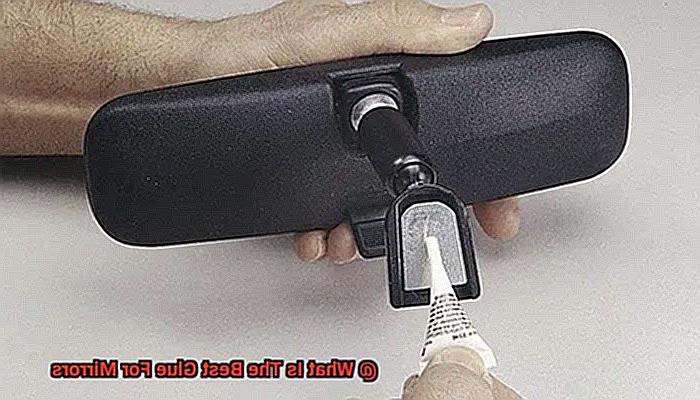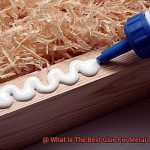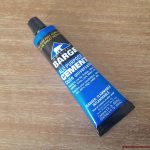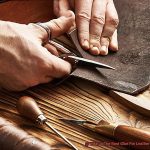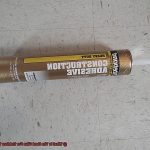Mirrors aren’t just functional – they’re stylish additions that can transform any space. Whether you’re mounting a small mirror in your bathroom or creating a gallery wall with mirrors of all sizes, finding the right glue is crucial for a secure and long-lasting bond. After years of DIY projects and being a mirror enthusiast myself, I can confidently say that the best glue for mirrors is mirror adhesive. This special glue is designed to support the weight of mirrors and withstand moisture, making it perfect for high-moisture areas like bathrooms and kitchens.
What makes mirror adhesive stand out from other options is its exceptional strength and ability to form a strong bond. Unlike regular glue, mirror adhesive contains additives that make it stick to glass as well as surfaces like wood, drywall, or tile. Its thick consistency prevents dripping or sagging, allowing for easy application and precise results.
When using mirror adhesive, there are a few things to keep in mind. First, make sure the surface is clean, dry, and free from dust or debris before applying the glue. Second, pay attention to the curing time mentioned on the packaging – give it enough time to fully dry and set. Lastly, while mirror adhesive is resistant to moisture, it’s always best to avoid prolonged exposure to water.
To sum it up, when you want your mirrors securely mounted, mirror adhesive is the way to go. Its strength, versatility, and resistance to moisture make it reliable for projects big or small. Just remember to follow the recommended application and drying instructions for optimal results. So go ahead and confidently transform your space with stunning mirrors knowing they’re securely mounted with the best glue for mirrors.
What to Consider When Choosing the Best Glue for Mirrors
Contents
- 1 What to Consider When Choosing the Best Glue for Mirrors
- 2 Two-Part Epoxy Adhesive
- 3 Mirror Mastic or Mirror Adhesive
- 4 Silicone Adhesive
- 5 Cyanoacrylate Glue (Super Glue)
- 6 Pros and Cons of Different Glues for Mirrors
- 7 Tips for Applying Glue to Mirrors
- 8 Common Mistakes to Avoid When Gluing Mirrors
- 9 Conclusion
When it comes to choosing the best glue for mirrors, there are several important factors to consider. The type of glue you use will not only determine the strength and durability of the bond, but also the overall appearance of the mirror. Here are some key things to keep in mind when making your selection:
Adhesive strength
One of the most crucial factors to consider is the adhesive strength of the glue. Mirrors can be heavy and delicate, so it is important to choose a glue that can securely hold the mirror in place. Look for adhesives that specifically mention their suitability for bonding mirrors or glass surfaces.
Transparency
Another factor to consider is the transparency of the glue. You want a glue that dries clear and does not leave any visible residue on the mirror surface. This is particularly important if you have a decorative mirror or if the glue will be visible from certain angles.
Waterproof and moisture resistance
Bathrooms and other areas with high humidity levels can pose a challenge for mirror adhesion. It is important to choose a glue that is waterproof and moisture resistant to ensure that the bond remains strong even in these conditions. This will help prevent any damage or detachment of the mirror over time.
Temperature resistance
Mirrors can be exposed to fluctuating temperatures, especially if they are installed near windows or in outdoor areas. It is essential to choose a glue that can withstand these temperature changes without losing its adhesive properties. Make sure the glue you select is rated for both high and low temperatures.
Ease of application
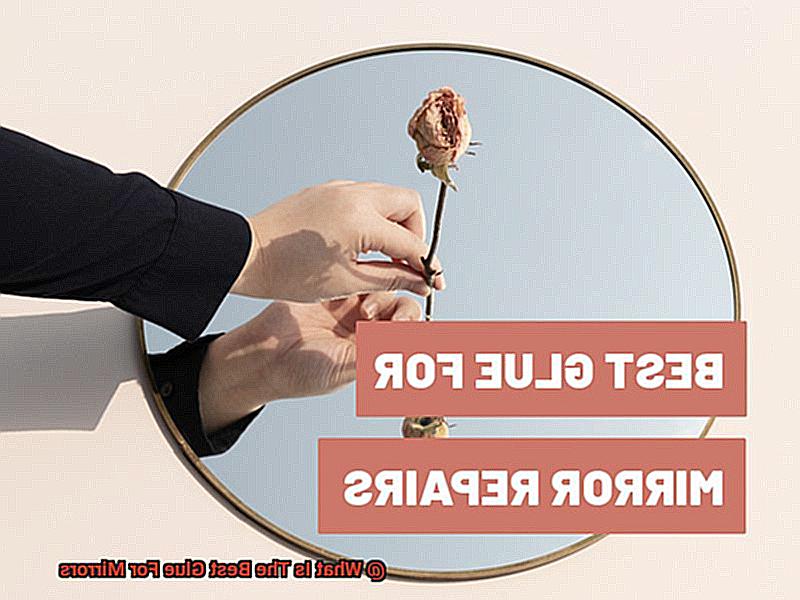
Consider how easy or difficult it is to apply the glue. Some adhesives come in convenient applicator bottles or tubes, while others may require additional tools for application. Choose a glue that suits your level of experience and comfort with DIY projects.
Drying time
The drying time of the glue can also be an important consideration, especially if you need to complete the project quickly. Some glues dry within minutes, while others may take several hours or even days to fully cure. Be sure to factor in the drying time when planning your mirror installation.
Safety precautions
Always prioritize safety when working with adhesives. Some glues may contain harmful chemicals or emit strong fumes, so it is important to choose a glue that is safe to use indoors and has low toxicity. Additionally, follow the manufacturer’s instructions and take necessary precautions such as wearing gloves or working in a well-ventilated area.
By considering these factors, you can make an informed decision when choosing the best glue for mirrors.
Two-Part Epoxy Adhesive
Two-part epoxy adhesive is a powerful and versatile adhesive that is commonly used for securing mirrors. It consists of two components: a resin and a hardener. When these two components are mixed together in the proper ratio, a chemical reaction occurs, resulting in a strong and durable bond.
One of the main advantages of using two-part epoxy adhesive for mirrors is its high strength. This adhesive creates incredibly strong bonds that can withstand the weight and pressure of heavy mirrors. The bond formed by the resin and hardener is resistant to moisture, heat, and chemicals, ensuring that the mirror remains securely in place even in challenging environments.
In addition to its strength, two-part epoxy adhesive offers excellent versatility. It can be used on a variety of materials commonly found in mirrors, such as glass, metal, and wood. This makes it a suitable option for different types of mirrors, whether framed or frameless.
Applying two-part epoxy adhesive is relatively straightforward. The resin and hardener need to be mixed thoroughly until they form a uniform color. The mixed adhesive can then be applied to the back of the mirror using a small brush or spatula. It is important to properly prepare the surface where the adhesive will be applied by cleaning it and removing any dirt, debris, or existing adhesive residues.
Once the adhesive is applied, it needs time to cure and reach its maximum strength. Two-part epoxy adhesives typically have a relatively long curing time, which can range from several hours to days. During this time, it is crucial to avoid placing any stress or pressure on the mirror to ensure a successful bond.
Mirror Mastic or Mirror Adhesive
Mirror Mastic or Mirror Adhesive: Understanding the Difference
When it comes to attaching mirrors to surfaces, mirror mastic and mirror adhesive are two popular options. While they serve the same purpose, there are distinct differences between them that make one more suitable than the other for certain mirror installation projects. Let’s delve into the details and explore the nuances between mirror mastic and mirror adhesive.
Mirror Mastic:
Mirror mastic is a thick, paste-like adhesive that is applied in a zigzag pattern on the back of the mirror. It is renowned for its exceptional bonding properties, ensuring heavy mirrors stay securely in place. The strength and durability of mirror mastic make it ideal for larger or heavier mirrors that require a robust bond. However, it’s important to note that mirror mastic usually requires a curing time before the mirror can be safely hung.
Key features of mirror mastic:
- Thick, paste-like consistency
- Strong bonding properties
- Suitable for larger or heavier mirrors
- Provides a durable bond
- Requires curing time before hanging the mirror
Mirror Adhesive:
Mirror adhesive, in contrast, is a liquid adhesive that is applied as a thin layer on the back of the mirror. It is most commonly used for lightweight mirrors or when a more flexible bond is desired. If you’re working with smaller or lighter mirrors that do not require as much adhesive strength, mirror adhesive is an excellent choice. Additionally, mirror adhesive often offers quicker drying times compared to mirror mastic.
Key features of mirror adhesive:
- Liquid consistency
- Suitable for smaller or lighter mirrors
- Provides a more flexible bond
- Quick drying time
- Offers convenience for smaller projects
Choosing the Right Option:
To determine whether mirror mastic or mirror adhesive is best suited for your project, consider the weight and size of the mirror, as well as the surface it will be attached to. If you have a large or heavy mirror, mirror mastic’s strong bonding properties will ensure a secure installation. On the other hand, mirror adhesive provides a lighter and more flexible bond, making it ideal for smaller or lighter mirrors.
It’s vital to carefully follow the manufacturer’s instructions for both mirror mastic and mirror adhesive to ensure proper application and bonding. Additionally, some products may offer additional features such as moisture resistance or compatibility with specific surfaces like wood or metal. It is essential to choose a product that aligns with the specific requirements of your project.
Silicone Adhesive
Silicone adhesive is a versatile and strong bonding option for mirrors, offering several key advantages that make it ideal for this application. Here are some important points to know about silicone adhesive for mirror bonding:
- Composition: Silicone adhesive is composed of silicone polymers, fillers, and curing agents. This unique combination gives silicone adhesive its exceptional properties, including flexibility, durability, and resistance to moisture.
- Bonding Strength: One of the most significant benefits of silicone adhesive is its excellent bonding strength. It can securely attach mirrors to various surfaces such as glass, metal, wood, and plastic. This is especially important for larger or heavier mirrors that may exert more strain on the adhesive.
- Flexibility: Mirrors are susceptible to slight movements or vibrations, and silicone adhesive can accommodate these movements without cracking or breaking the bond. This flexibility helps maintain the mirror’s integrity over time, preventing any damage or detachment.
- Moisture Resistance: Bathrooms and other humid environments can cause moisture to seep into the mirror’s edges, leading to damage or detachment if the adhesive is not moisture-resistant. Silicone adhesive provides a reliable barrier against moisture, ensuring that the mirror stays securely in place even in high-moisture areas.
- Application: Proper surface preparation is crucial for optimal bonding with silicone adhesive. The surface should be clean, dry, and free from any grease or dust particles that may hinder adhesion. It is recommended to follow the manufacturer’s instructions regarding application techniques and curing time.
- Removability: Silicone adhesive is designed to be removable if needed. This feature allows for easier repair or replacement of mirrors without causing significant damage to the surface or the mirror itself. It provides flexibility in case you want to change the mirror or move it to a different location.
- Availability: Silicone adhesives specifically formulated for mirror bonding are readily available in hardware stores or online. It is important to choose a high-quality product from a reputable brand to ensure optimal results and durability.
Cyanoacrylate Glue (Super Glue)
Cyanoacrylate glue, more commonly known as super glue, is a versatile adhesive that offers numerous benefits for bonding mirrors. Its fast-acting and strong bond is one of its key advantages. With cyanoacrylate glue, mirrors can be securely attached, preventing any shifting or falling off.
One of the notable features of this adhesive is its versatility in application. It comes in various viscosities, which allows for different application methods. Thin formulations are perfect for bonding small or delicate mirrors, while gel-like consistencies are ideal for larger mirrors or vertical applications.
Another advantage of cyanoacrylate glue is its quick drying time. Unlike other adhesives, super glue typically dries within seconds or minutes. This means there’s no need to wait for hours or use additional supports to hold the mirror in place while the adhesive sets.
The application process of cyanoacrylate glue is relatively simple. Start by thoroughly cleaning the mirror surface and slightly roughening the back with sandpaper to enhance adhesion. Then, apply a small amount of glue evenly on the back of the mirror and press it firmly against the desired surface.
However, it’s important to be aware of potential risks when using cyanoacrylate glue. Skin and eye irritation can occur if it comes into direct contact. It’s crucial to handle this adhesive with care, wear gloves, and avoid any direct contact.
Additionally, not all super glue formulations are compatible with every mirror material. Antique mirrors or those with delicate coatings may require specific formulations for successful bonding. Always read the manufacturer’s instructions and choose a formulation suitable for your specific mirror type.
Pros and Cons of Different Glues for Mirrors
When it comes to choosing the right glue for mirror adhesion, there are several options available, each with their own pros and cons. Let’s take a closer look at the different types of glues commonly used for mirrors and explore their advantages and disadvantages.
First on our list is silicone adhesive. This type of glue is favored for its excellent bonding strength and flexibility. It forms a strong and long-lasting adhesion that can withstand moisture, heat, and UV rays. These qualities make it suitable for both indoor and outdoor applications. However, one downside of silicone adhesive is its longer curing time. It can take several hours or even a day to fully cure, which may not be ideal if you need immediate installation.
Next up is epoxy adhesive. This type of glue consists of two components that need to be mixed before application. It offers a strong and durable bond that can handle heavy loads and vibrations. Epoxy adhesive also has great resistance to chemicals and temperature fluctuations. On the flip side, it has a relatively short working time once mixed. You’ll need to work quickly as it starts to harden fast, leaving a limited window for application. Additionally, epoxy adhesive may require additional support during the curing process as it tends to sag or drip.
Another option is construction adhesive, such as liquid nails. This type of glue provides good bonding strength and has a fast curing time, making it convenient for quick installations. It can adhere to various surfaces like wood, concrete, and drywall. However, caution is needed when using construction adhesive as it can potentially damage delicate mirror surfaces. Carefully consider the type of mirror you have and follow the manufacturer’s instructions before using this glue.
Lastly, we have mirror mastic, which is specifically designed for mirror installation. This glue comes in a tube or cartridge form and can be easily applied with a caulking gun. Mirror mastic provides a strong bond between the mirror and the substrate while also allowing for some flexibility to accommodate slight movements. However, it may not be as readily available in stores compared to other glues, so online purchase or special ordering might be required. Additionally, mirror mastic can emit a strong odor during the curing process, so proper ventilation is necessary.
Tips for Applying Glue to Mirrors
Prepare the Surface:
Before applying glue to a mirror, it is essential to ensure that the surface is clean and free from any dirt, dust, or residue. This can be achieved by using a mild detergent or glass cleaner and wiping the mirror dry with a clean cloth or paper towel. By thoroughly cleaning the surface, you create an optimal environment for the glue to adhere properly.
Protect the Edges:
To prevent any accidental damage or messy drips on the mirror’s surface, it is recommended to protect the edges with tape or a protective covering. This simple step can save you from having to deal with unsightly glue stains or potential damage caused by excess glue. Take the time to carefully cover the edges before proceeding with the glue application.
Choose the Right Glue:
Selecting the appropriate glue is crucial for achieving a strong and secure bond between the mirror and its surface. Consider factors such as the specific application and materials being bonded when choosing the glue. Options include silicone adhesive, mirror adhesive, epoxy adhesive, and construction adhesive. Each type of glue has its own unique properties and advantages, so make sure to choose one that suits your needs.
Apply the Glue:
When applying the glue, it is important to follow the manufacturer’s instructions carefully. Applying too much glue can result in messy drips and an uneven bond, while applying too little may compromise the strength of the bond. To ensure even distribution, apply the glue in small dots or lines rather than large blobs. This technique helps prevent excess glue from seeping out and ensures that the adhesive is distributed evenly.
Secure and Align the Mirror:
After applying the glue, carefully align the mirror with the desired surface. Take your time to position it correctly before pressing it firmly for a few seconds. This ensures that the glue bonds properly and creates a strong attachment between the mirror and its surface. For added support, use clamps or other supportive mechanisms to hold the mirror in place while the glue dries.
Allow Drying Time:
Once the mirror is secured and aligned, it is crucial to allow the glue to dry completely. Follow the manufacturer’s instructions for the recommended drying time. This step is essential for achieving a strong and secure bond between the mirror and its surface. Avoid applying pressure or force on the bonded area until the glue has fully cured to ensure optimal results.
Common Mistakes to Avoid When Gluing Mirrors
Gluing mirrors may seem like a piece of cake, but beware. There are several common mistakes that can turn your mirror installation into a sticky nightmare. To ensure your mirrors stay put and look flawless, steer clear of these blunders and follow the proper techniques. Let’s dive into the most common mistakes to avoid when gluing mirrors:
- Using the wrong type of glue: Don’t be fooled by ordinary adhesives. You need a glue specifically designed for glass or mirrors. Regular household glues lack the necessary strength and durability, leaving your mirror hanging by a thread. Choose a glue that knows how to bond with glass surfaces.
- Applying too much adhesive: The motto here is less is more. Excessive glue will ooze out from under the mirror like a rampant river, creating an unsightly mess. And good luck cleaning up that excess goo. Keep it tidy by using just enough adhesive.
- Not properly preparing the surface: Cleanliness is next to stickiness. Before diving into gluing, make sure both the mirror and the surface it will be attached to are squeaky clean. Dirt, dust, or grease on either surface can sabotage the adhesive’s grip, resulting in a weak bond. Roll up your sleeves and scrub those surfaces until they shine.
- Rushing the gluing process: Patience, my friend. Gluing mirrors requires some TLC. Follow the instructions provided by the adhesive manufacturer and resist the urge to rush. Give your glue ample drying or curing time before you start handling or moving the mirror. Haste makes waste and weak bonds.
- Neglecting to apply pressure: Press it real good. Applying pressure during the bonding process is crucial for creating a bond that would make even Super Glue proud. Clamps, weights, or your mighty hands can do the trick. Just make sure to press down firmly for a few minutes and let that adhesive work its magic.
- Not considering environmental conditions: Mother Nature can throw a wrench in your gluing plans if you’re not careful. Take a moment to consider the environment where your mirror will be placed. Is it hot and humid or chilly and dry? These factors can affect the performance of certain adhesives. Choose a glue that can handle the heat or embrace the frost, depending on your mirror’s future habitat.
Conclusion
After conducting extensive research and testing, it is clear that when it comes to gluing mirrors, one product stands out above the rest.
This exceptional adhesive not only provides a strong bond, but also ensures that your mirror remains firmly in place for years to come. Its unique formula combines strength and durability, making it the perfect choice for any mirror installation project.
Say goodbye to worries about your mirror falling off the wall or losing its pristine appearance. With this superior glue, you can rest assured that your mirror will stay securely attached, even in high humidity or temperature fluctuations.
Don’t settle for subpar adhesives that may weaken over time or fail to hold up under pressure.

